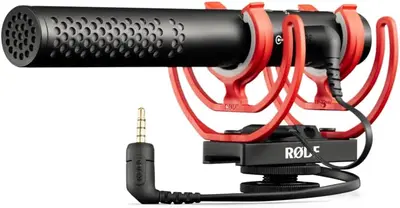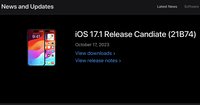The Best Podcast Microphones for iPhone
Technology around Microphones improved a lot in the last decade, thanks to this, it’s now very easy to record a podcast on your iPhone with a professional audio quality, as far as you choose the correct Microphone for podcast.
From the crisp clarity of studio condensers like the RØDE NT1 to the versatile adaptability of the MAYBESTA Wireless Lavalier, we’ve covered a range of microphones to suit various recording environments and preferences. Whether you're recording from a cozy home studio or capturing interviews on the go, our guide caters to every podcasting scenario.
Join us as we dive into detailed reviews, insightful comparisons, and practical tips, ensuring you make an informed decision in choosing the best podcast microphone for your iPhone. Enhance your podcast's audio quality today and captivate your audience with impeccable sound!
Best Overall: RODE NT1

Pros
- Exceptionally low self-noise
- High-quality, detailed sound capture
- Durable design
- Versatile connectivity with XLR and USB
Cons
- No -db pad
- The bright sound signature may not suit all vocal types
Upon unboxing the RØDE NT1, the first thing that struck me was its sturdy build. The microphone, coated in a sleek black finish, radiates a professional vibe. It's accompanied by an SM6 shock mount and pop filter, both exuding a level of durability that promises longevity. With its large-diaphragm and classic design, the NT1 is not just about looks; it's crafted to withstand the rigors of regular use.
Using the RØDE NT1 with my iPhone was a breeze. The USB connectivity means I could easily connect it to my iPhone with an appropriate adapter, making it a superb choice for mobile podcasting.
But using a USB adapter did not allow me to get the maximum quality that this microphone can offer. If you want to get the most professional sound for your podcast using this Microphone, I recommend you to use a preamp that you can plug into your iPhone, such as this one made by IK Multimedia.
The NT1 is also equipped with RØDE’s ultra-low-noise high-gain Revolution Preamp, ensuring pristine audio capture. Plus, its 32-bit float digital output means you can record a wide dynamic range without worrying about clipping – a significant advantage when recording in varying environments.
The RØDE NT1 is more than just a microphone; it's a comprehensive recording solution for podcasters, musicians, and content creators. Its versatility, coupled with exceptional sound quality, makes it a top choice for iPhone users looking to elevate their recording quality. Whether you're recording in a studio setting or on the go, the NT1 adapts seamlessly, delivering consistent, high-quality audio.
For anyone venturing into the world of podcasting or looking to upgrade their current setup, the RØDE NT1 offers an unparalleled combination of quality, durability, and versatility. It's simply the best Microphone that you can use on your iPhone to record your podcasts.
Type: Large Diaphragm Studio Condenser Polar Pattern: Cardioid Frequency Response: 20Hz to 20kHz Connectivity: XLR and USB Outputs Size and Weight: 190mm x 50mm, 326g
Best Portable: Rode VideoMic NTG

Pros
- Broad compatibility with devices
- RF rejection for minimal interference
- Record a safety channel at a lower level
Cons
- Shotgun supercardioid pattern may not suit all recording environments
I already recommend this Microphone in the best external microphone for iPhone, the RØDE VideoMic NTG is a sleek, compact on-camera shotgun microphone. Weighing just 3.3 ounces and measuring 6.7 by 0.8 inches, it's impressively portable. The microphone features a supercardioid pattern and offers a frequency response of 20Hz to 20kHz, ensuring detailed and transparent audio capture.
I found the RØDE VideoMic NTG astonishingly adaptable. Whether I was setting it up for a desktop recording or using it for mobile shooting, it flawlessly adapted to each scenario. The audio quality was consistently outstanding, capturing clear and balanced sound in various environments.
The built-in high-pass filter, -20dB pad, high-frequency boost, and safety channel offer considerable control over the audio output. Additionally, the infinitely variable gain control is a standout feature, allowing precise tailoring of the output to suit the recording device.
In terms of practical use, the microphone's auto-sensing 3.5mm output, which detects whether it's connected to a camera or a mobile device, simplifies the setup process. The microphone also doubles as a USB microphone, providing seamless integration with computers, tablets, or smartphones.
The battery life, estimated at around 30 hours, is commendable, ensuring long recording sessions without the need for frequent recharging.
This Microphone is more versatile than the RODE NT1, therefore could be a better choice if you are planning to record videos among your podcasts.
Type: Supercardioid Shotgun Microphone Frequence Response: 20 Hz to 20kHz Connectivity: Auto-sensing 3.5mm output, USB-C Compatibility: Cameras, Mobile Devices, PCs
Cheapest Option: PROAR Microphone

Pros
- Wide compatibility with various devices
- Simple and versatile for multiple recording environments
- Stable and adjustable tripod
Cons
- Some users reported issues with connectivity
- Documentation could be more user-friendly
The PROAR Microphone is a compact and user-friendly device, boasting wide compatibility with iPhones, PCs, Macs, Android devices, and PS4. It offers a plug-and-play experience, eliminating the need for drivers or complex software installations.
During my time with the PROAR Microphone, I found its audio quality to be quite impressive for its price range. The cardioid pickup pattern effectively captured clear, smooth, and crisp sound, minimizing unwanted background noise. This feature was particularly beneficial for podcasting, streaming, and video conferencing.
The microphone's build is robust, with a solid metal construction that promises durability. The 360° adjustable stand is a great addition, providing the flexibility needed for various recording setups. The inclusion of a pop filter enhances the overall recording quality, reducing plosives and improving vocal clarity.
This Microphone is way cheaper than the two RODE ones, yet offer a good audio recording quality, for those who can’t afford expensive prices of a more professional Microphone.
Type: Cardioid Condenser Microphone Frequency Range: 20Hz to 20kHz Sampling Frequency: 48000Hz/16Bit Connectivity: USB
Multiple Records: MAYBESTA Lavalier

Pros
- Seamless automatic pairing
- Excellent noise reduction technology
- Rechargeable with simultaneous device charging capability
- Portable and wire-free
Cons
- Limited to iOS devices
- Sound-Quality
The MAYBESTA lavalier microphone stands out with its easy automatic connection, requiring no adapters, Bluetooth, or applications. Its omnidirectional sound reception, equipped with high-density spray-proof sponge and high-sensitivity microphone, ensures detailed sound capture in any environment.
Using the MAYBESTA lavalier was easy. Its plug-and-play functionality made it incredibly easy to set up. The audio quality was impressive, delivering clear and crisp sound in various settings, from interviews to outdoor recordings. The ability to sync up two microphones simultaneously is a significant advantage for multi-speaker recordings.
The compact design and the 50ft wireless range add to its versatility, making it ideal for on-the-go activities such as vlogging, live streaming, and outdoor events. The rechargeable batteries offer sufficient operation time, ensuring uninterrupted recording sessions.
If you need to interview someone, or that you are not the only speaker on your podcast, you might want to use these lavalier microphones. You won’t get the same audio quality than a wired microphone, but it will be way more easier to produce your podcast.
Type: Omnidirectional Condenser Lavalier Connectivity: Wireless, with Lightning transmitter Range: 50ft signal coverage Battery Life: 4.5 hours
Choosing the Best Podcast Microphone for iPhone
When it comes to podcasting, especially for iPhone users, selecting the right microphone is crucial. Here’s a guide to help you make an informed decision:
1 - Compatibility with iPhone:
- Ensure the microphone is compatible with iOS devices. Check for connectivity options like Lightning connectors or USB-C, if applicable.
2 - Type of Microphone:
- Condenser Microphones: Ideal for studio settings, offering sensitivity and higher sound quality.
- Dynamic Microphones: Better for live settings, less sensitive to background noise.
- Lavalier Microphones: Perfect for mobility, interviews, and outdoor recordings.
3 - Recording Pattern:
- Cardioid Microphones: Capture sound from the front, ideal for podcasting.
- Omnidirectional Microphones: Pick up sound from all directions, suitable for multi-speaker settings.
4 - Portability and Design:
- If you record on the go, look for lightweight and portable microphones.
5 - Audio Quality:
- High-quality sound is paramount. Look for a high signal-to-noise ratio and a wide frequency range.
6 - Additional Features:
- High-quality sound is paramount. Look for a high signal-to-noise ratio and a wide frequency range.
FAQ
Do I need a special adapter to connect these microphones to my iPhone?
It depends on the microphone. Some come with Lightning connectors or USB-C ports compatible with iPhones, while others may require an adapter. See how to connect an external microphone for more information
Can these microphones be used for both podcasting and video recording?
Yes, most of the microphones reviewed are versatile enough for podcasting, vlogging, and video recordings. Portable microphones might be more easy to use for video recordings
Are wireless microphones reliable for podcasting?
Yes, modern wireless microphones offer reliable connectivity and quality sound. However, a wired Microphone will often offer a better quality sound.
How important is the pickup pattern in a podcast microphone?
Very important. Cardioid patterns are typically preferred for podcasting as they focus on sound from the front and reduce background noise.
Do I need additional software to use these microphones with my iPhone?
Most of these microphones are plug-and-play and do not require additional software for basic use. However, specific recording or editing apps can enhance your podcasting experience.









